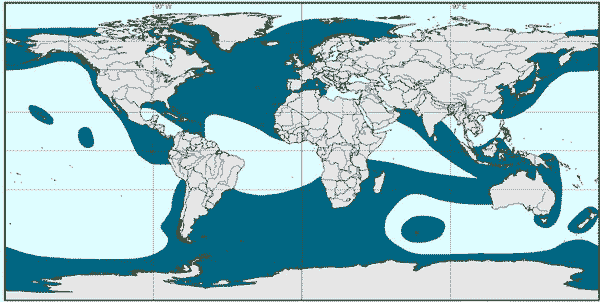
|
Taxonomical
status
| Appearance
| Distribution and migrations | Reproduction and development
Taxonomical status Killer whales (Orcinus orca) are members of the order Cetacea,
suborder Odontoceti.
Killer whales belong to Delphinidae family. Species name - Orcinus orca Linnaeus, 1758.
Appearance
Killer whales are the largest dolphins in the world. Males can grow up to 10 meters in length; females are smaller — up to just 8 meters in length. The sex of mature orcas can be discerned by the size and shape of the dorsal fin: the male has an elongated dorsal fin, up to 2 meters high. Females and subadult animals of both sexes have smaller sickle-shaped dorsal fins.
One key species feature of killer whales is their coloration. The back and sides of the large body are black; the lower jaw, throat and belly are white. On the rear part of the body, the white color goes up the sides, sometimes culminating at the back.  Two white patches are located before the eyes and above them. Behind the dorsal fin there is an asymmetrical saddle patch, which is used for the photo-identification of individual whales. In Arctic and Antarctic waters, this white color can be masked by algae covering the orca´s skin and these patches appear fawn or brown. Killer whales have 10-14 teeth on the each half of the upper jaw and 8-14 on the lower. When the mouth closes, the teeth of the upper jaw fit into the spaces between the teeth of lower jaw, helping to catch and bite prey. Two white patches are located before the eyes and above them. Behind the dorsal fin there is an asymmetrical saddle patch, which is used for the photo-identification of individual whales. In Arctic and Antarctic waters, this white color can be masked by algae covering the orca´s skin and these patches appear fawn or brown. Killer whales have 10-14 teeth on the each half of the upper jaw and 8-14 on the lower. When the mouth closes, the teeth of the upper jaw fit into the spaces between the teeth of lower jaw, helping to catch and bite prey.
Distribution and migrations
Killer whales are found across the world’s oceans, near the coast and in the open sea and have been called the second most widely distributed mammal on Earth after humans. In the Atlantic Ocean, orcas are found everywhere from Greenland to the Antarctic seas. They are common visitors to the Strait of Gibraltar and sometimes move into the western Mediterranean Sea. They inhabit the Indian Ocean and Australian waters, and during the summer season they are seen throughout Antarctic seas. In the Arctic their distribution is discontinuous: orcas don’t dwell in the East Siberian Sea and Laptev Sea, but they do live in Barents Sea, the western and north-western parts of the Karskoye Sea, near the Murman coast and in the White Sea. In the Russian Far East, killer whales are often observed in the East (Japan) and Okhotsk Sea, near the Kamchatka peninsula, around the Komandor and Kuril islands, and in the Bering Sea. At 1951 Russian scientist A.G. Tomilin noted that in Kamchatka coastal waters killer whales had often been observed near Shipunskiy Cape, where a rookery of Steller sea lions was located, and in the Olutorskiy and Avacha Gulfs.

Geographical distribution of killer whale
Reproduction and development
The mating of killer whales has rarely been observed in the wild, but studies of stranded animals in the North Pacific suggest that impregnation in some areas takes place during the summer season and early autumn. The gestation period is about 15-18 months. In Canadian waters females give birth between October and March. The reproductive cycle of killer whales may vary between areas. For example, Russian researchers Y.I. Ivanova and V.А. Zemskiy reported that the birth of calves takes place during summer months, and Norwegian researchers show that calves are usually born in the autumn. Newborns are 250-270 centimeters in length, and yearlings reach 350 centimeters. Females calve only about once every five years and mortality between the ages of birth to six months can be as high as 50 percent. This means a very low birth rate and population growth rate.
Females and males reach maturity at about 15 years of age, though sexual maturity may be earlier for females. The age of growing males can be established using the HWR coefficient (height of the dorsal fin to its width), with each value corresponding to the fixed age of the killer whale male. The maximum life span of killer whales has not been established precisely, but in 1987 Olesiuk and his colleagues observed two females around the age of 77 years old. Based on the number and known age of the calves of certain females, it has been established that they can reach 90 years of age. Based on the proportions of the sex classes of orcas aged 35, it is supposed that male life span is much shorter than that of females and doesn’t exceed 50 to 60 years. Average life span is of course much less, about half of these maximum numbers.
|
|
|

|


